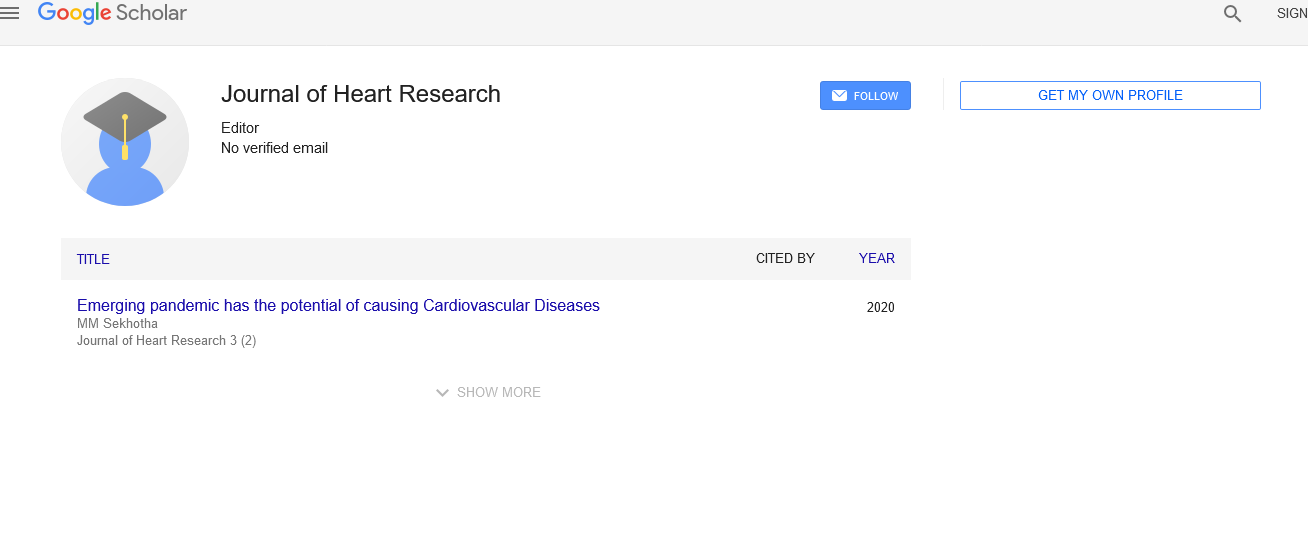Treatment of Cardiomyopathy and its Symptoms
Received: 03-Dec-2021 Accepted Date: Dec 17, 2021; Published: 24-Dec-2021, DOI: 10.37532/ puljhr.2022.
This open-access article is distributed under the terms of the Creative Commons Attribution Non-Commercial License (CC BY-NC) (http://creativecommons.org/licenses/by-nc/4.0/), which permits reuse, distribution and reproduction of the article, provided that the original work is properly cited and the reuse is restricted to noncommercial purposes. For commercial reuse, contact reprints@pulsus.com
Editorial
Cardiomyopathy is a group of diseases that affect the heart muscle. At first there may be few or no symptoms. As the disease progresses, breathing, fatigue, and swelling of the legs may occur, due to the onset of heart failure. Unusual heartbeat and fainting may occur. Those affected are at greater risk for sudden cardiac death. Types of cardiomyopathy include hypertrophic cardiomyopathy, dilated cardiomyopathy, restrictive cardiomyopathy, arrhythmogenic right ventricular dysplasia, and cardiomyopathy (broken heart disease). In hypertrophic cardiomyopathy the heart muscle grows and thickens. In extended cardiomyopathy the ventricles grow and become weaker. In obstructive cardiomyopathy the ventricle tightens.
In most cases, the cause cannot be determined. Hypertrophic cardiomyopathy is usually inherited, and dilated cardiomyopathy is inherited in about one third of cases. Dilated cardiomyopathy can also cause alcohol, heavy metals, coronary artery disease, cocaine use, and bacterial infections. Restrictive cardiomyopathy may be caused by amyloidosis, hemochromatosis, and other cancer treatments. Broken heart disease is the result of intense emotional or physical stress. Treatment depends on the type of cardiomyopathy and the severity of the symptoms. Treatment may include lifestyle changes, medications, or surgery. Surgery may include a ventricular relief device or a heart transplant. In 2015 cardiomyopathy and myocarditis affected 2.5 million people. Hypertrophic cardiomyopathy affects about 1 in 500 people while extended cardiomyopathy affects 1 in 2,500. They resulted in 354,000 deaths from 294,000 in 1990. Arrhythmogenic right ventricular dysplasia is more common in young people.
Cardiomyopathies are confined to the heart or are part of a generalized systemic disorder, both of which often lead to cardiovascular death or further related heart failure. Other diseases that cause cardiovascular dysfunction are excluded, such as coronary heart disease, high blood pressure, or heart valve failure. Often, the underlying cause is still unknown, but in most cases the cause is obvious. Alcohol, for example, has been identified as a cause of dilated cardiomyopathy, as is toxic to drugs, as well as certain diseases (including Hepatitis C). Untreated celiac disease can cause cardiomyopathies, which can be completely reversed with timely diagnosis. In addition to the known causes, molecular biology and genetic engineering have led to the recognition of various genetic causes. The best clinical stage of cardiomyopathy such as ‘hypertrophied’, ‘dilated’, or ‘restrictive’, is difficult to maintain because some conditions can achieve more than one of those three stages at any stage of their development. The current definition of the American Heart Association (AHA) classifies cardiomyopathies into primary, single, and second cardiac, which are the result of diseases that affect other parts of the body. These categories are further subdivided into smaller collections combining new knowledge of genetic science and molecular biology.
Treatment may include suggesting a lifestyle change to better manage the condition. Treatment depends on the type of cardiomyopathy and the nature of the disease, but may include medications (conservative treatments) or iatrogenic / implanted pacemakers implanted heart rate, defibrillators for those with a fatal heart rate, ventricular aids (VADs) severe heart failure, or the release of recurrent dysrhythmias that cannot be eliminated with medication or cardioversion mechanically. The goal of treatment is usually to relieve symptoms, and some patients may eventually need a heart transplant.
Acknowledgement
None
Conflict of Interest
None





